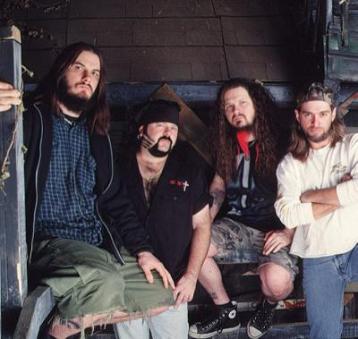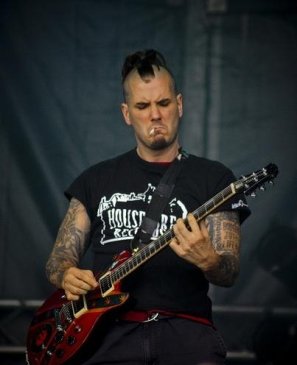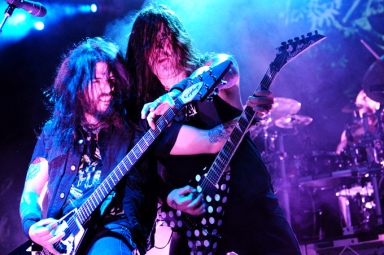There is a mighty instrument that cannot be produced by human hands. It creates music of the finest and most various kind: it can be raw and low, soft and sweet, shrill and icy. Its existence is endless and its power is great. It can put masses under its spell and arouse controversy. This instrument is the human voice.
Most modern music thrives on extraordinary voices and charismatic lead singers with outstanding vocal capabilities. It is a matter of taste whether you appreciate of the mainstream radio’s latest musical wonders or turn towards heavier spheres, yet the significance of voices is doubtless in both cases.
Heavy Metal is alive with powerful vocal chords, and vocalists have long since become the figureheads of their bands. Particular to Metal is the way the human voice and its limits are explored: apart from clean singing, heavy music includes growling, shouting, screaming and quite a number of other more or less appropriate sounds. Vocal abilities are fathomed by leading the human voice through pitches ranging from low to high, and eliciting sounds from it that no other musical style employs. Thus, the Heavy Metal world has born sons and daughters with some of the most extraordinary voice spans in the realm of modern music.
I have been fascinated with Metal voices from the start, without ever being able to explain what exactly made them so attractive to me. The first voice I ever admired, however, belonged to a man who created everything from Art Rock to Pop, yet never a Metal song. Freddie Mercury was the lead singer of British band Queen from 1970 until his untimely death in 1991. Despite the lack of professional training, Mercury possessed one of the world’s greatest voices. In his biography “Freddie Mercury Story: Living on the Edge” (1996), author David Bret describes the singer’s voice as moving “from a deep, throaty rock-growl to tender, vibrant tenor, then on to a high-pitched, perfect coloratura, pure and crystalline in the upper reaches.” Small wonder that Mercury recorded a full album with Spanish soprano Montserrat Caballé, who was astonished and fascinated with his enormous vocal precision and diversion. Today, Freddie Mercury’s voice is said to have had a range of more than four octaves, which renders it unrivalled. It was hard for me to make a choice, but wait and hear.
“Innuendo” (from the 1991 album of the same title) is one of the most impressive songs I know:
Mercury’s wonderfully clear voice sounds magnificent in “Don’t try so hard” (from “Innuendo”):
Caballé and Mercury’s well-known duet “Barcelona” (from “Barcelona”, 1988) was made the official anthem of the 1992 Summer Olympics in Barcelona. It is only one beautiful example for the two singers’ fruitful cooperation:
Metal voices rarely equal Mercury’s in octave range, yet they display a range of sound as well: it is in the same way astonishing to hear someone growl in a low pitch, only to sing clearly and high-pitched thereafter. Christian Älvestam, former singer of Melodeath artists Scar Symmetry, does exactly this. Before I had seen a music video of the band, I was under the belief that two singers were performing for the Swedish act, so vast appeared the difference between his kinds of voice. The clarity of Älvestam’s high singing is astounding, and perfectly supported by the contrast of his low barks and growls.
Amazing vocal combinations in “Veil of Illusions” (from “Symmetric in Design”, 2005):
There are even different nuances in Älvestam’s growling, at times turning it into a caw or scream, as in “The Kaleidoscopic God” (from “Pitch Black Progress”, 2006)
In “Timewave Zero” (from “Holographic Universe”, 2008) Älvestam proves that his high-pitched voice is absolutely clean:
Far less fine, yet powerful all the same, is the vocal span of Phil Anselmo. The former singer of Pantera, nowadays mostly active under the banner of Down, has passed through several stages of vocal expression, and has proven thereby his enormous range of voice. Powerful screaming that borders on ranting is combined with high-pitched clean singing which resembles a classical Heavy Metal style. In contrast to Älvestam, however, Anselmo rarely combines his different abilities, rather he appears to go through them as he moves from one record to the next.
Go on a “Psycho Holiday” (from the 1990 record “Cowboys from Hell”):
Pantera’s longest song ever includes Anselmo’s competition with Dimebag Abbott’s guitar. Listen to his high pitch at 4:55 in “Cemetery Gates” (from “Cowboys from Hell”, 1990):
Screaming and growling are Anselmo’s new techniques in “I’m Broken” (from “Far Beyond Driven”, 1994):
Simply cool: “13 Steps to Nowhere” (from “The Great Southern Trendkill”, 1996)
Amazing instrument, the human voice.



